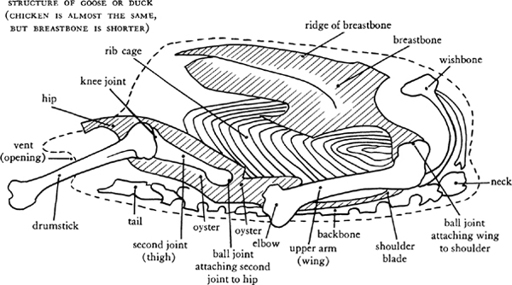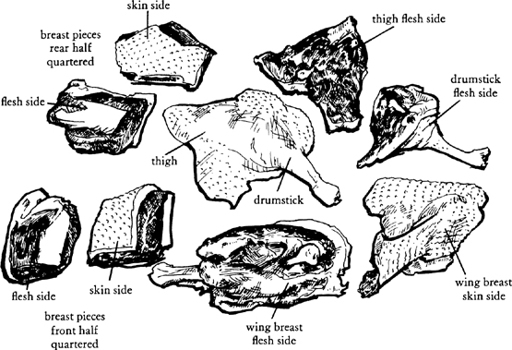Mastering the Art of French Cooking, Volume 2 (134 page)
Read Mastering the Art of French Cooking, Volume 2 Online
Authors: Julia Child

To serve, cut into slices, like a large pie.
(*)
STORAGE NOTE
:
Jambon persillé
will keep nicely for a week under refrigeration. It may be frozen, but will lose character after 2 to 3 weeks.
PRESERVED GOOSE
Confit d’Oie
(And the Disjointing of Fowl and the Rendering of Fat)
Like the salting of pork, the preserving of goose is an age-old method for keeping meats during the winter months, and is typical of the
foie gras
regions in France, where geese are raised to produce those magnificent livers. The goose for
confit
is given a brief preliminary salting, then is slowly simmered in its own fat, a process that not only cooks it but also renders out most of the heavy layer of fat under the skin, just as most of the fat is rendered out of bacon when you cook it. Traditionally, the cooked pieces of goose are then packed in crocks and sealed in the fat for storage. The taste of preserved goose, like the taste of salted pork, has a very special quality quite unlike fresh goose or pork, and it is an easy process as well as an interesting one to do. Besides having goose to eat in the numerous ways described at the end of the recipe, you will have its big carcass for soup and, during the weeks to come, a goodly supply of the best cooking fat imaginable, which is marvelous for browning
meats and sautéing potatoes, for basting roasts, frying eggs, and broiling chickens, as well as for flavoring vegetables like cabbage and sauerkraut.
HOW TO DISJOINT POULTRY, AS ILLUSTRATED WITH A GOOSE
In the following directions, the goose is cut so that each wing makes a serving portion, the breast is halved lengthwise, and the drumstick-second-joint pieces are left intact for separation before serving.
Preliminaries
Pull all fat out of cavity; you will have about 2 cups from a ready-to-cook store-bought goose, 4 or more from a farm goose. Cut off wings at elbows and save for the stock pot, along with the neck and gizzard; save the heart and liver for the sausage suggestion at the end of the
confit
recipe. As a preliminary to disjointing the goose, slit skin the length of the back, going down to the bone from neck opening to beginning of tail piece. Then place goose in front of you, its legs to your left.
Removing the wing section
So that the wing will make an adequate serving, you want to include the lower third of the breast with it as follows. Starting an inch to the right of where second joint is attached to hip, in the drawing, cut through breast meat to bone in a shallow semicircle reaching up to the joint where wing is attached to shoulder. Bend wing at a right angle away from breast and then down toward back, to break open the joint; cut through joint to free wing, and scrape breast meat off carcass from initial cut down toward backbone to free the entire section.
Removing drumstick-second-joint section
Follow end of drumstick with your finger to find knee. Holding knee in your left hand, slit around it from vent to ribs (where wing section was removed). Again with your finger, follow second joint (thigh) from knee to hip, to locate ball joint attaching it to the hip bone. At either side of this joint along the hip are two nuggets of meat, the oysters, which should come off as part of the drumstick-second-joint section: scrape this meat from hip bone up to and around joint. Then bend knee away from carcass at a right angle and down toward backbone to break open ball joint at hip. Cut through joint to detach it, then cut drumstick-second-joint from carcass. Remove wing-breast piece and drumstick-second-joint from other side of goose.
The breast
You now have only the upper two thirds of the breast meat left on the carcass. Cut through ribs just below breast meat on either side. Then, grasping tail end (at left in drawing), lift breast structure up at right angles and bend it toward neck end, to break it free at shoulder. Chop off the 2 tusk-shaped shoulder-blade bones at neck end and trim off excess skin.
Locate ridge of breastbone with your finger, then slit down through skin to bone close along one side of ridge. With cleaver and mallet, chop the breastbone in half along this slit. (You may then wish to chop each piece in half, crosswise, if you are serving the goose in a
ragoût
rather than a
confit.
)
Trim fatty edges of skin from each piece of goose; feel with your fingers for any knobs of fat buried under the flesh at edges of breast, wings, second joints, and remove them. You will have 3 or more cups of fatty skin pieces to add to the fat from inside the goose. Cut into ½-inch pieces with shears, and reserve all of this for rendering, Step 2 in the recipe.
A NOTE ON COOKING-FAT
Ideally the goose is cooked in goose fat and fresh pork leaf fat (also called fresh leaf lard), which comes from around the pork kidneys. This is very difficult to find unless there is a pork-slaughtering business in your area: substitute fresh pork fatback or the fat from a loin roast. If you have no success in finding this, render only the fresh fat and skin from the goose, and after you have strained it, add store-bought leaf lard, which you can usually buy in 1-pound packages. Failing this, use white vegetable shortening.




